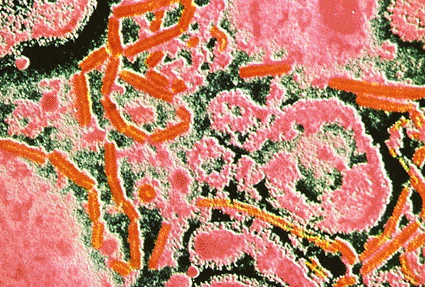RT-PCR Assay Detects and Differentiates Parainfluenza Viruses
By LabMedica International staff writers
Posted on 21 Apr 2009
A real time-polymerase chain reaction (RT-PCR) assay rapidly detection and differentiates parainfluenza viruses 1, 2, and 3.Posted on 21 Apr 2009
Real-time technology offers clear advantages over other molecular diagnostic techniques such as microbeads and microarrays because little hands-on time is required, risk of amplicon contamination is eliminated, equipment cost is relatively low, and inducement concerns (resulting from running a large panel of tests, some of which may not be medically-indicated) are minimized.

Image: Colored transmission electron micrograph (TEM) of many virus particles of the parainfluenza virus type 1, also known as the Sendai virus (Photo courtesy of CNRI / SPL).
The ProParaflu+ assay is an in vitro diagnostic product; it yields an objective answer within 3 hours. It is a product of Prodesse Inc. (Milwaukee, WI, USA), a biotechnology company focused on developing molecular diagnostic reagents for a variety of infectious disease applications. Together with ProFlu+ (for influenza viruses) and Pro hMPV+ (for metapneumovirus) the three respiratory products offer seven detections and share an internal control. This enables clinicians to easily run the most appropriate series of tests for their patients from just a single nucleic acid extraction.
Human parainfluenza viruses are a common cause of respiratory infections, especially in children; it is second only to respiratory syncytial virus as a cause of hospitalization of pediatric patients. Parainfluenza 1 virus is the leading cause of croup in children. Parainfluenza 3 is often associated with bronchiolitis and pneumonia. The elderly and the immunocompromised are also at higher risk for lower respiratory tract infections from parainfluenza viruses. Current methods for detection require subjective interpretation from highly skilled laboratory technicians and can take several days to provide a result.
The Prodesse's products can be used on multiple nucleic acid extraction and RT-PCR platforms. The company has filed a submission with the U.S. Food and Drug Administration (FDA; Rockville, MD, USA) for 510(k) clearance to market its ProParaflu+ assay in the United States.
Related Links:
Prodesse Inc.
U.S. Food and Drug Administration













